_We may earn revenue from the products available on this page and participate in affiliate programs. Learn more ›
_
The first whitetail deer I ever took with a bow was an 8-point buck that lowered his head and smashed my plastic decoy
, sending roto-molded ears and antlers and legs flying in all directions. Then he stood there staring at the pieces strewn on the ground while I managed to stop shaking enough to send an arrow through him. When I walked up to that buck, my knees still knocking, I thought, So, this is bowhunting for deer.
And in a sense, it is. Because while this doesn’t happen every time, of course, it is just the sort of thing you see while archery hunting but rarely do when gun hunting. As some people say, “Bowhunting begins where gun hunting ends.” In other words, if I’d had a rifle on that hunt, I would have shot the buck long before I got to watch him obliterated my decoy. In the time between first seeing a buck and waiting for it to move into bow range, you can witness some pretty wild stuff—all up close and personal.
I think that’s why people love bowhunting deer so much and why bowhunters tend to be a little obsessed with their sport. Because there’s nothing quite like being within rock-throwing range of a mature whitetail buck that has no idea you’re around. And bowhunting whitetails forces you to get that close.
If you’re reading this, you are probably either looking for advice on bowhunting for beginners or you’ve been at it a while and want some fresh advice. We’ve got you covered in each case. If you’re an experienced archer, you may want to skip to the section on top bowhunting tactics. For everyone else, let’s start with the reasons why you should start bowhunting deer or should be glad you recently did.
Bowhunting for Beginners and Beyond—Four Great Reasons to Get Started
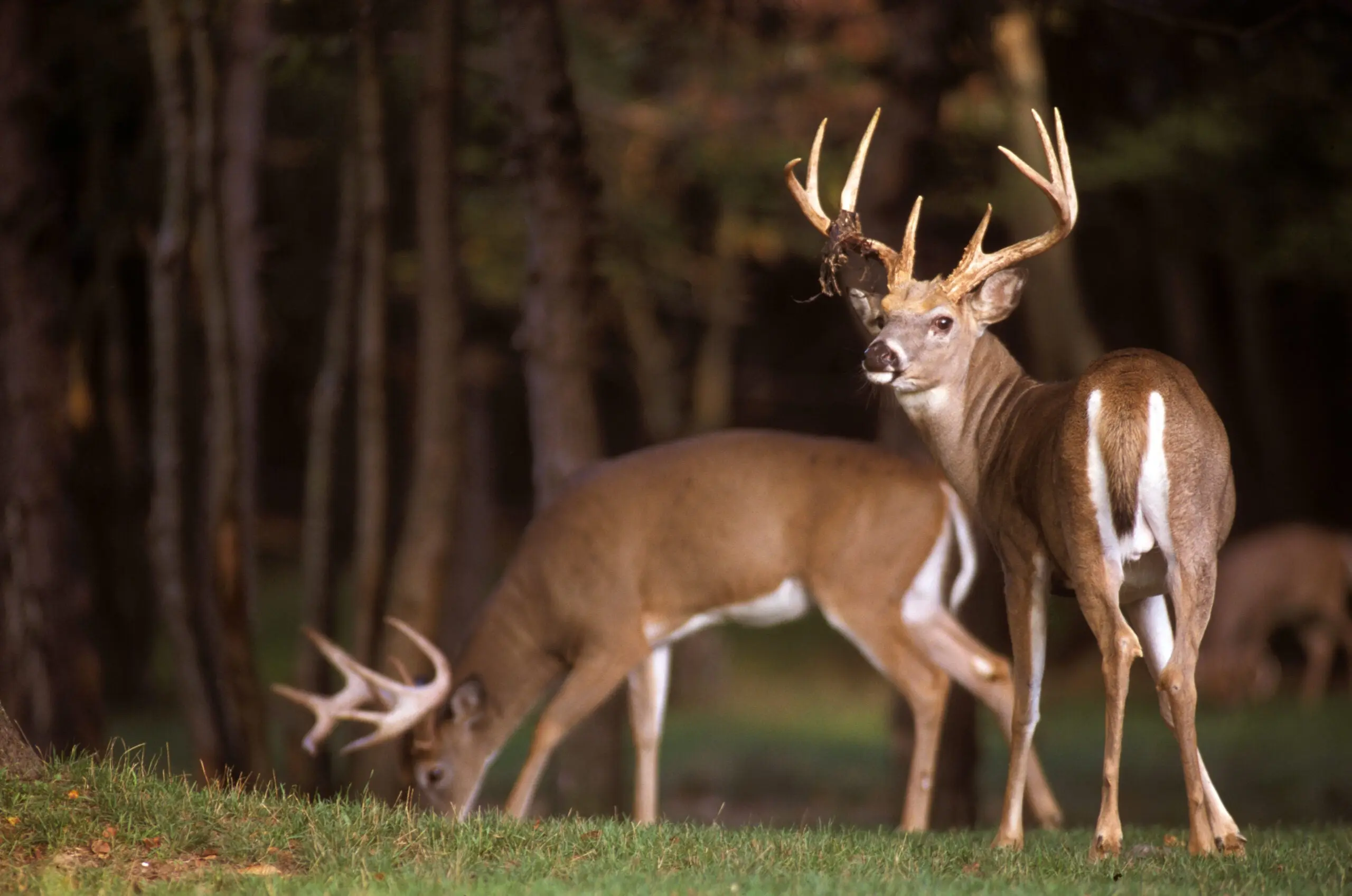
One of best reasons to bowhunt is that you’ll see more deer, as bucks are far less pressured and more visible during early bow seasons. John Hafner Photography
They say converts make the best zealots, and that was the case for me with bowhunting whitetails. I hunted deer exclusively with a rifle for years, but after taking that first archery buck, I became an archery hunting nut. And why not? There are so many good reasons to get into bowhunting. Here are just four of them.
1. You’ll Spend More Time Hunting
In some states, the bow season for whitetail deer begins more than two months before the gun season and continues for weeks afterward. Depending on where you live, you can double, triple, or even quadruple your deer hunting opportunities just by taking up archery hunting.
2. You’ll See More Deer
Because bow seasons starts so much earlier than most gun seasons, and because the number of bowhunters pales in comparison to gun hunters, whitetail bowhunters usually get first crack at relatively unpressured deer, which are much more likely to be on their feet during daylight. On early-season bowhunts, it common to watch deer pour into open feeding areas hours before dark and mill about with hardly a care.
3. You’ll See More Deer Behavior
In many states, the gun season does not open until after the rut, which means much of the coolest buck behavior—rubbing, scraping, sparring, seeking, chasing, fighting—happens primarily during the bow season. If you want to see it, you need to be out there. Last year, in early October, I watched four bucks step into a field and work a scrape, one after the other, and then start sparring with one another. Then I called all of four of them across the field and into bow range by snort-wheezing
and arrowed the biggest. A buddy of mine who only hunts deer with a gun said, “I’ve never seen anything like that in the woods.” And I said, “You need to start bowhunting.”
4. You’ll Become a Better Deer Hunter
Getting within bow range of a whitetail buck isn’t easy. To do it consistently, you need to up your game in just about every department, from scouting and reading terrain to understanding deer behavior and picking the perfect ambush. Bowhunting deer is a challenge, but it’s also fun and rewarding to get better with every season.
The Gear You Need for Bowhunting Deer

Bowhunting whitetails requires a fair amount of specialized gear. Elite Archery
Picking the perfect compound bow for you is an article all its own, but that’s okay because I’ve already written it, and you can check it out here
. There’s more to bowhunting deer, however, than just the stick and string. Here’s a quick rundown of some of the key gear you’ll need.
Compound Bow
Two key general points here: First, get a new or recent model. Over the last few years, compound bow efficiencies have soared and new components and materials have made recent models much quieter and more pleasant to shoot. You don’t have to drop a grand or more on this year’s flagship
if you don’t want to; the latest mid-priced bows are often better than the top models from only five or six years ago, and you can find nicely priced used models that were the latest and greatest just a few years ago. Even today’s best budget bows
are very good. Just get something fairly new for archery hunting, and you’ll be happy you did.
Second, if you’re new to this process, buy your bow from a local pro shop, or, at the very least, buy accessories
there and have the pro set your new bow up. A good pro will work with you individually so that when you leave the shop, your bow will be totally set up and ready for you to start shooting it—and shooting well.
**_Related: The Best Compound Bows of 2022
_**
Crossbow
In many states, you can use a crossbow
instead of or in addition to a compound bow for archery hunting. The upside of a crossbow is that it has a much shorter learning curve, especially if you’ve hunted with a rifle before. Most crossbows today come with everything you need, including a scope. Just put it together, sight it in, and you’re good to go.
Arrows
Again, if you’re new to this, work with your local pro to choose arrows. Micro-diameter shafts are all the rage for bowhunting deer, as they improve trajectory and penetration, but they aren’t cheap. Standard carbon arrows work just fine if you want to save a few bucks.
**_Related: Best Hunting Arrows for 2022
_**
Broadheads
There’s been a long-running debate over which type of broadhead is better for whitetail bowhunters, fixed-blades or mechanicals. No one has a definitive answer. Fixed are more reliable and tougher. Mechanicals tend to fly better and make a big hole. Get either from a reputable brand, and you’ll be fine.
**_Related: The Best Broadheads of 2022
_**
Range Targets
Being proficient with a bow requires practice, and for that, you’ll need an archery target or two. Bag targets are comparatively inexpensive but are made for shooting with field tips only. Block-shaped foam targets can typically be used with both field points and broadheads. This is a big plus, because while you’ll practice mostly with field points, you will want to take at least a few shots with your hunting broadheads to make sure they are hitting in the same place as your field points. I have one of each. I do most of my practicing with the bag target and shoot broadheads only on my foam target, which, as a result, has lasted for years.
You don’t need a foam 3D deer target, but when it comes to practicing for shots at deer in the field, nothing is better. There are no aiming dots on a deer, of course, and a 3D target teaches you how to mentally pick an aiming spot in the vital area of a whitetail and hit it.
Tree Stands
Tree stands aren’t exclusive to archery hunting, of course, but they are especially helpful for getting into bow range of a buck because they get you out of the deer’s line of sight and help keep your scent above your quarry. This is another topic that requires its own article, and F&S whitetails editor, Scott Bestul, has already written this one, which you can read here
.
Ground Blinds
More and more archers are hunting deer from the ground these days and using pop-up ground blinds to do it. These camo hides obscure the movement required to draw a bow, and the enclosed space helps to contain your scent. Keep in mind that for deer, as opposed to turkeys, you need to put a blind out ahead of time and brush it in well.
**_Related: Best Hunting Blinds of 2022
_**
Calls
Whitetail bowhunters use deer calls
more than most gun hunters out of necessity, because sometimes, you need to coax a deer into bow range, and a grunt tube, bleat call, or rattling antlers can do just that.
Decoys
Same goes for deer decoys. A sub-dominant buck decoy, placed in bow range, can lure a real buck in for a fight, just as a doe decoy can bring a rutting buck in for the opposite.
Wind Check
Every deer hunter should have a wind check, but it’s an absolute must for whitetail bowhunters. A deer can’t smell you unless the wind or thermals carry your scent to its nose. For that reason, most deer hunters try to stay downwind or crosswind of where they expect deer to show, but whitetail bowhunters must be obsessive about this because they have to get so close. It’s called playing the wind
, and you can’t do it unless you know which way the wind, no matter how slight, is blowing.
Scent-Control Products
Some gun hunters use scent-control products, but they are most associated with whitetail bowhunters because getting bow-close to deer is a lot easier if the deer can’t smell you. Which brings us to another hot debate
: Do products that promise to hide or even eliminate your scent—sprays, shampoos, carbon clothing, rubber boots, even chewing gun—really work? For many bowhunters, the fact that they might provide an edge, if only a small one, makes them worth it. Skeptics believe in just playing the wind.
Shot Placement for Bowhunting Deer
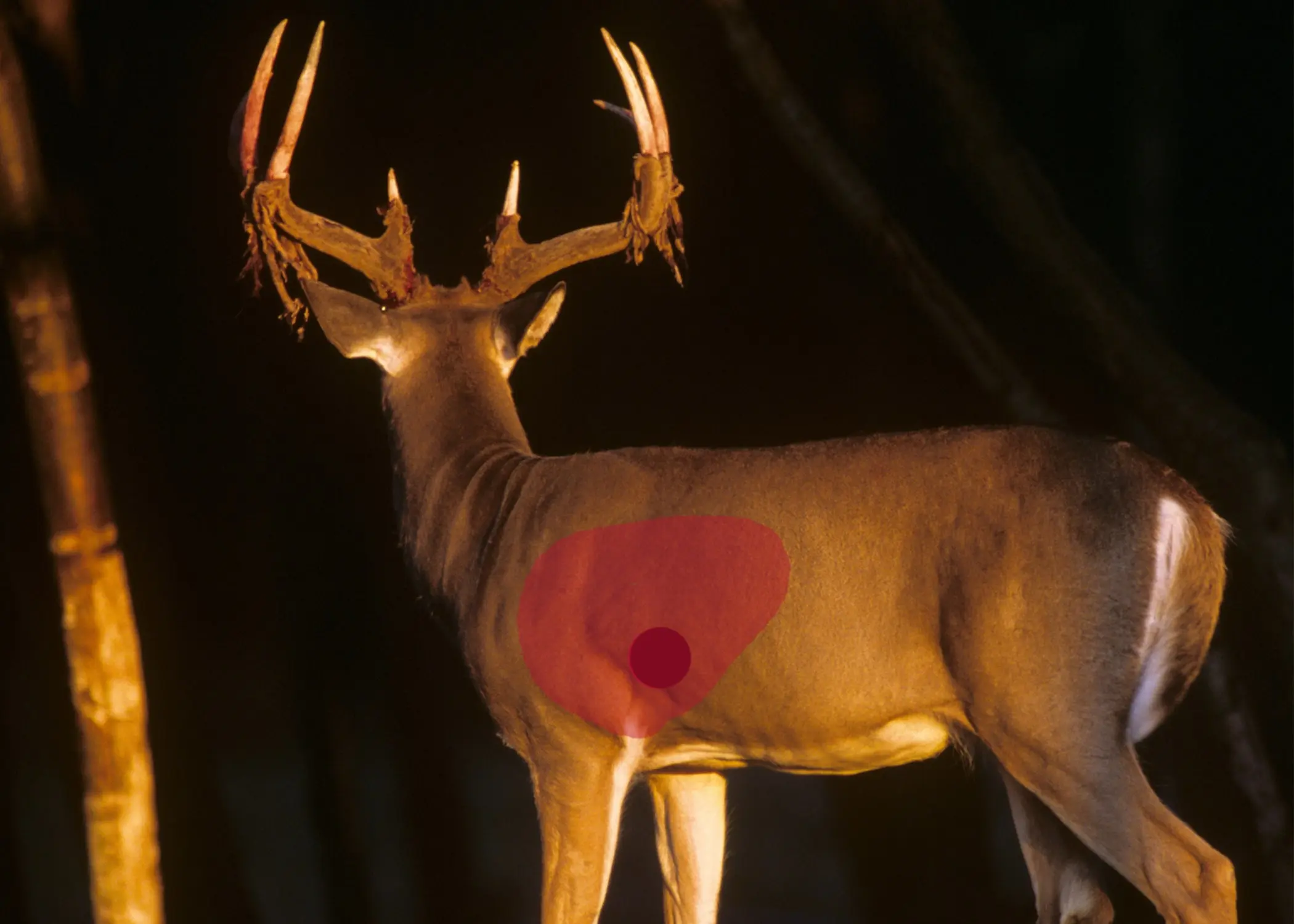
The light-red color approximately outlines the vital area (heart and lungs) of a whitetail deer. The dark red is where you should aim at a broadside buck, just behind the shoulder crease. Photo by John Hafner Photography
So, you’ve got all your gear together. You’ve done some practicing on the range. You’re just about ready to start archery hunting. But before you step into the woods, you need to review exactly where to aim at a deer with a bow. If you’ve hunted with a gun, you know that the vitals of a deer sit between and extend a little way behind the front shoulders of a broadside deer. With the right bullet, you can expect to shoot through heavy muscle and bone to reach those vitals. But it’s different with a bow. Or at least, it always has been.
For as long as anyone can remember, whitetail bowhunters have been told to aim behind the front shoulder and, whatever you do, do not hit the front shoulder, because it will stop your arrow cold before it reaches the vitals. So, traditionally speaking, the only shots you should take when bowhunting deer is when the animal is broadside (in perfect profile), quartering away, or very slightly quartering to. On a broadside deer, you aim just behind the front shoulder crease about a third of the way up the body to puncture both lungs. On a quartering-away shot, you aim a little farther back, in line with the opposite leg, so that the arrow drives forward into the vitals. On a slightly quartering-to shot, you aim as tight as possible to the front shoulder without hitting it.
Now, all of that said, with today’s powerful bows and crossbows and deep-penetrating micro-diameter arrows, more and more whitetail bowhunters are less and less concerned about the bones and muscles of the front shoulder stopping their arrows. As a result, some aim right in the shoulder crease or even ahead of it on a broadside deer. Some will also take a hard-quartering-to shot by aiming in the crease between the point of the shoulder and the chest. And when shooting at does, some will simply blast right through the front shoulder with a tough, fixed-blade broadhead.
Personally, I’m old-school on this one. I think the biggest target, with the most room for error and least amount of bone and muscle to get through is behind the shoulder, so I always wait for that shot. (But if you want to read a hot debate on this topic between F&S hunting editor Will Brantley and me, here it is
.)
Getting Started Bowhunting Deer

Lee Lokosky draws his bow from an early-season stand. Summit Tree Stands
Even if the archery hunting season has begun already in your state, it’s not too late for you to start bowhunting deer this year. Today’s compound bows are so good that a week of practice on the range may well be enough for you to feel confident taking your bow into the woods, so long as you set your maximum distance at a conservative range. (Keep in mind that according to Pope and Young Club records, the average bow-killed buck is shot at just 17 yards; so you don’t have to shoot far to be successful.) If you’re hunting with a crossbow, you may need only a few days on the range to get ready.
The next hurdle is getting a place to hunt, which can be a challenge for new hunters in general. The good news is that bowhunters have a couple advantages in this regard. First, public-land spots are comparatively unpressured during archery season and can therefore provide surprisingly good hunting. I hunt two public places, and although I see a few trucks along the road or in the parking lots, I rarely bump into another hunter in my hunting spots. Second, it’s often easier to get permission on private land if you are bowhunting only.
With a place to hunt secured, the next step is to do some scouting and set up an ambush. This isn’t the only way to bowhunt whitetails. (It’s possible to spot and stalk a buck, and a few bowhunters stage careful drives
.) But stand-hunting from a tree stand or blind is by far the most common and successful method. Here’s the basic drill:
Step 1: Scout
Before you begin hunting, use binoculars to glass open feeding areas in the late-afternoon and evening to see where deer are entering food sources. Also walk the woods to find sign—tracks, trails, dropping, rubs
, scrapes, and beds—that reveal where deer are most active. (Note that in the early season, you should avoid penetrating the woods more than 50 or 75 yards or so at first, so as not to disturb deer bedding close to food sources.)
**Related: The Best Cheap Binoculars for Serious Hunters
**
You don’t have to run trail cameras
to be successful, but they can be very helpful. If you decide to use them, now is the time to set a few up pointing at the best trails you found either entering feeding areas or heading toward a suspected dense-cover bedding area. Or make a mock scrape just inside the woods or along a field edge, and set up trail cams there.
**Related: How to Make a Mega Mock Scrape
**
Your goal is to find a few places where deer are traveling or feeding predictably during daylight. This is called patterning deer, and a good pattern can be as simple as learning that a nice buck enters a particular corner of a crop field or food plot every evening or two, about an hour before dark.
Step 2: Pick Your Spot
Your next step is to pick a tree if you’re using a tree stand, or a specific spot if a ground blind, where you can wait inconspicuously for the deer to show—and where you’ll have a high-odds bow shot and the wind will blow your sent away from the deer.
In the example above, this might simply be a tree within bow range of the corner of the field. But it might not. If the wind is wrong there, or there’s not enough cover, you may need to move into the woods slightly to cut the deer off or back off on the edge of the field and lure the deer into bow range. Success in bowhunting often boils down to picking the perfect ambush site, and with the best hunters, this becomes almost an art form.
Step 3: Set Up a Stand or Blind
In the case of a tree stand, you can go to your ambush spot at midday a day or two before or even the same day as your hunt and set up. It’s a good idea to bring a buddy, which makes it easier and safer to hang a stand, and make sure you wear a harness and have a safety line. Hang the stand as quietly as possible, then trim shooting lanes, and you’re ready to go. With a ground blind, you’ll want to put it up at least several days before your first hunt, and be sure to brush it in well with natural vegetation.
Step 4: Wait Out Your Deer
Keep a close eye on the weather forecast, and when the wind direction will carry your scent away from where you expect the deer to show, go to your stand or blind and wait quietly while you watch and listen for approaching deer. In the early season and late season, most bowhunters prefer evening hunts near feeding areas. They’ll get there in the afternoon and sit until dark, waiting for deer to come out and feed. Late-October through the rut is the best time to hunt in the mornings. Get to your stand or blind before first light and sit at least until midmorning, trying to catch a buck heading back to its bed or covering ground to find does.
Rattling, Calling, and Decoying Whitetail Deer
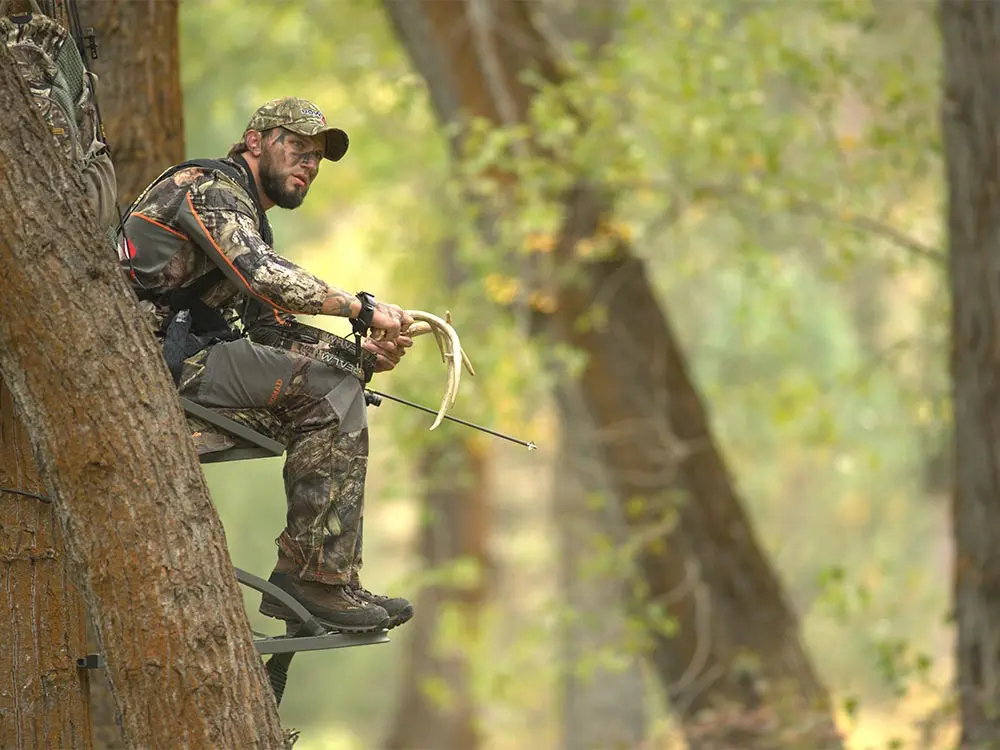
An early-season bowhunter tickles a set of rattling antlers. John Hafner/Bowtech
Whitetail deer are social critters and will respond to the sights and sounds of other deer all through the fall and winter, whether it’s bow season or gun season. But archers need to be especially skillful at rattling, calling, and decoying deer, because done correctly, these tactics can be just the ticket for luring bucks close enough for a good bow shot. So, here’s a rundown of each.
Rattling in Deer Into Bow Range
When bucks bang heads, other deer often come running, like kids who can’t resist rushing in to watch a playground fight. Imitating these brawls with a pair of real antlers or a rattle bag can be an excellent way to bring a buck into bow range. You should start quietly, by just tickling the antler tines together, in case a buck is very close. Then click and mash the tines a little louder. If there’s still no response, go ahead and get loud: Start with a sharp, aggressive whack of the antlers, and then slide off into a series of bangs and bunks to mimic two bucks beating on each other. Remember, too, that any buck fight involves a lot of pushing and twisting, so grind the antlers together, too. All the while, keep your bow handy; more than once I have had bucks run in so quickly that I had to scramble to prep for a shot, and once I was simply caught flat-footed mid-sequence. I had to watch as the buck stared at me, realized he’d been fooled, and spun to leave.
A mature buck, especially, is apt to circle downwind of the sound. So try to set up upwind of an obstacle (like a fence, steep slope, or river bank) that will prevent or discourage him from swinging around and getting your wind. One great solution is to put a buddy downwind of the horns to stop a circling buck cold.
**Related: How to Rattle In Whitetail Deer in the Fall
**
Calling Deer Into Bow Range
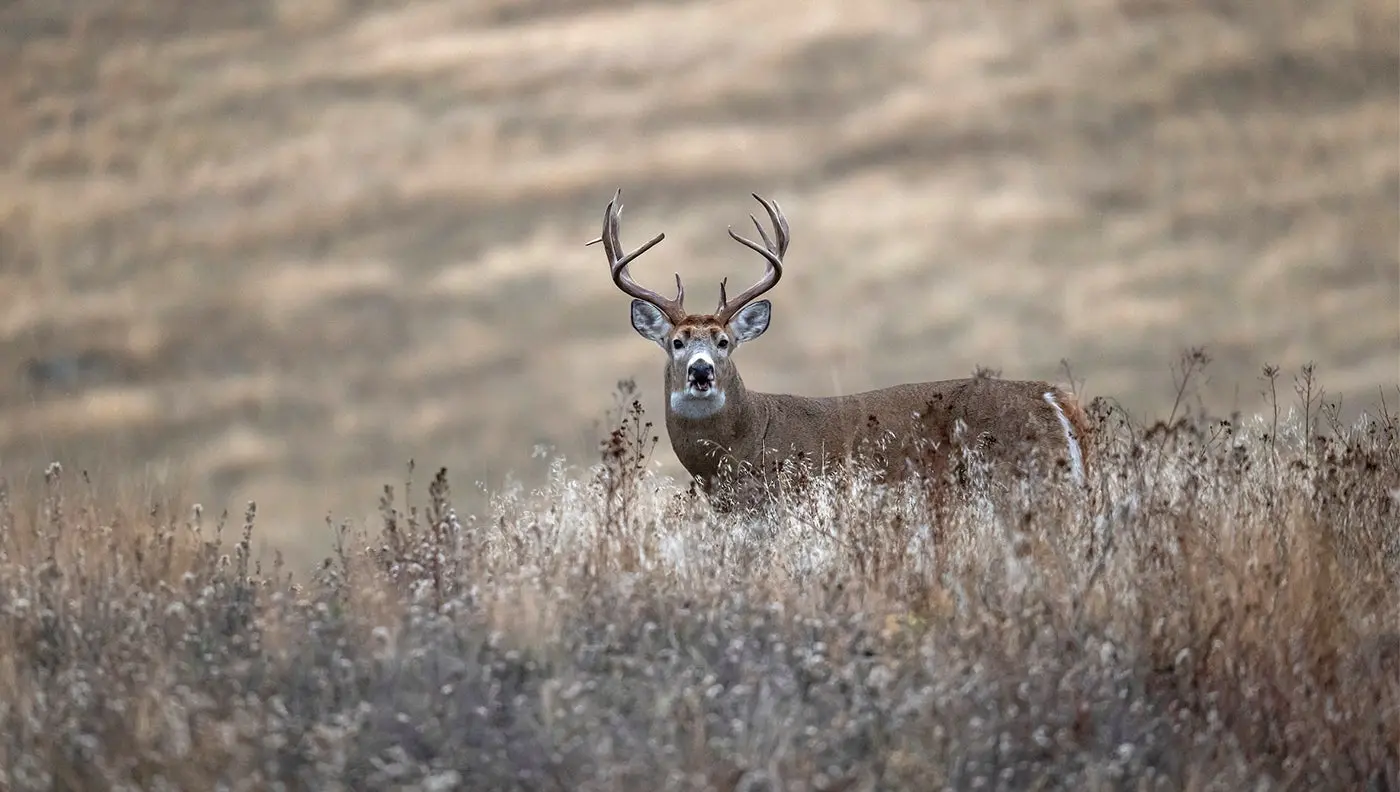
You’ll know when a buck has heard you call, because he’ll almost always stop and stare, and may call back. John Hafner Photography
Deer are highly social critters that “talk” to each other all the time. Bucks have their ears peeled for any deer vocalization, especially during the rut, so luring in a nice whitetail can be as simple as mastering these three basic sounds. Here’s a quick rundown.
Blow a Bleat
The go-to sound deer make to greet or stay in contact with each other is a bleat. As the name implies, the bleat is a soft, sheep-like baaah. It’s most easily mimicked using a tip-over call like The Can, but reed-style calls offer better control of sound, inflection, and volume.
Give a Grunt
While does grunt too, the sharp uurp (yup, it sounds like a belch, and sometimes a loud one) of a rutting buck is unmistakable. There are scads of effective user-friendly grunt calls out there on the market. If you see a buck and he’s walking right to you, great, let him. But if he isn’t, give him a grunt or two, and he’ll often change course and come in.
Sound a Snort-Wheeze
Snort-wheezing can be surprisingly effective during the pre-rut
, but it’s usually thought of as a peak-rut call. At that time, bucks who are either seriously pissed off or sexually frustrated will make the sound. While this is a last-ditch challenge call, a snort wheeze will often bring in a buck when nothing else will. Happily, you don’t have to buy anything to make this sound. Just inhale rest your top teeth on your lower lip and breathe out a sharp, three-note, phht, phht, phhhhhhhhttt.
**Related: Call in More Whitetail Deer With These Expert Tips
**
Decoying Deer Into Bow Range
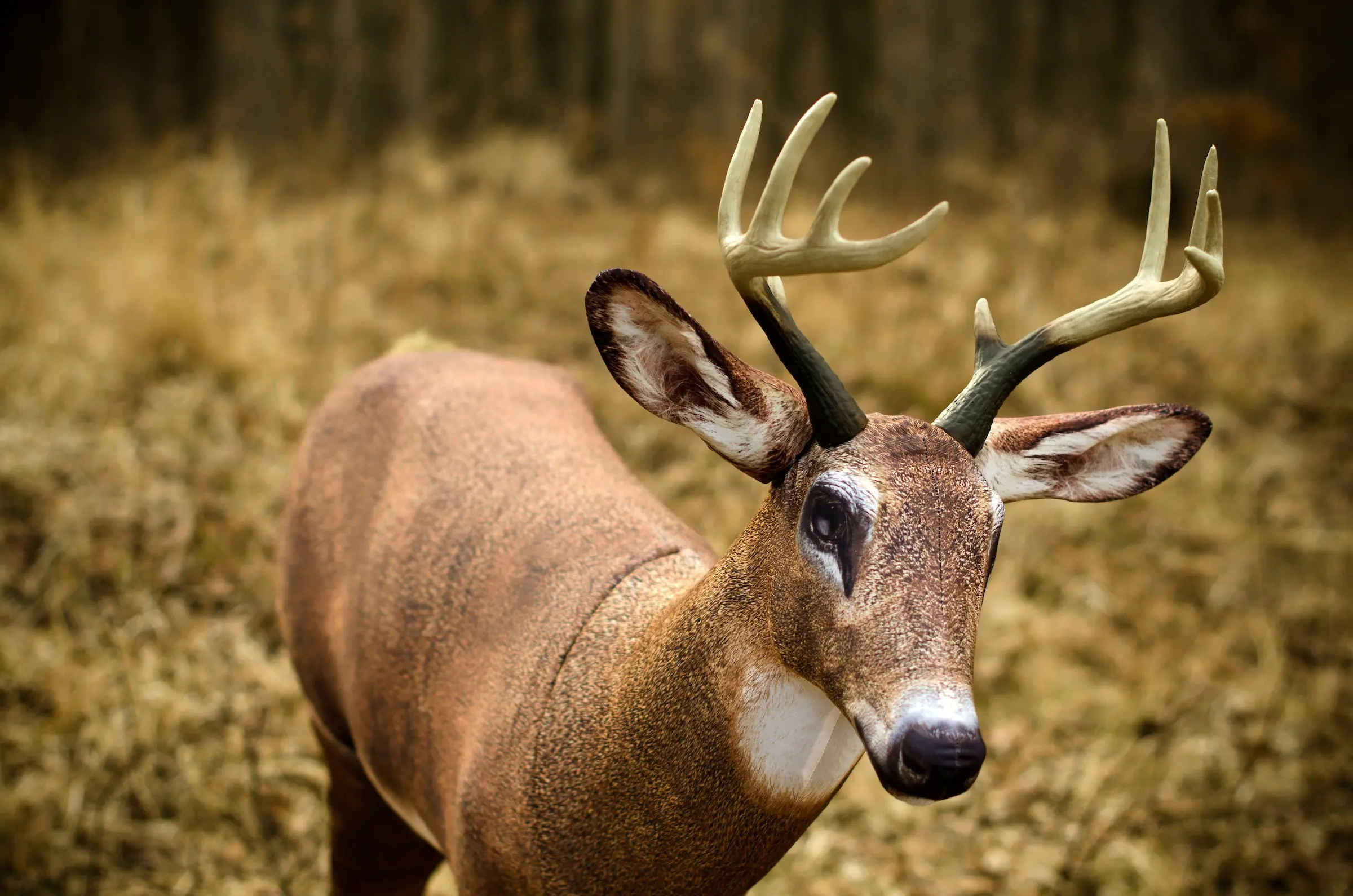
A subdominant buck decoy can lure a big whitetail into bow range. John Hafner Photography
A deer decoy can work wonders for pulling a buck into bow range, and when it works it can make for the most exciting hunt of your life (see the first paragraph of this article). To be successful, though, you need to know when to use a decoy and how to set it up correctly. Here are some good rules of thumb.
Rule 1: Choose the right decoy.
Use a subdominant buck decoy as your go-to fake for luring in bucks, and a doe decoy if you’re targeting does. Two exceptions: When specifically targeting a giant buck, you may need to bust out a dominant buck deke. Also, it can pay to play the jealousy card during the rut by using a doe decoy or adding one to your buck setup.
**_Related: Best Deer Decoys of 2022
_**
Rule 2: Find an opening.
Keep your decoy in relatively open cover so that bucks can spot it easily. Decoys placed in brush, tall grass, or dense timber can surprise and spook an approaching buck.
Rule 3: Put it in easy bow range.
In most situations, 15 yards upwind of your setup is about right. Bucks will approach the fake and circle tightly to get a few yards downwind, putting them only about 10 yards away, which makes for an easy bow shot. A few bucks will walk right up and face your fake, which puts them in easy range too.
Rule 4: Eliminate odor.
Your decoy is going to get a thorough sniffing from any approaching deer, so do your best to eliminate odors on the fake before you get into your stand. Spray the fake down head-to-tail with scent-eliminating spray. It doesn’t hurt to add some buck or doe urine nearby too.
Rule 5: Adjust your setup.
In the early season, stake a subdominant buck decoy so it’s facing toward the most likely buck entry trail. A buck will interpret the fake’s steady stare as a challenge and come in to investigate. During the pre-rut, when bucks are covering more ground, stake a subdominant buck decoy in a known travel corridor and then rattle or call cruising bucks in for a look. During the rut, place a bedding doe decoy in a visible spot with a subdominant buck decoy standing nearby to play on the jealousy of other bucks. Finally, after the rut, place buck-and-doe feeding decoy pair on a hot food source.
**Read Next: How to Decoy Bucks for the Hottest Action of the Rut
**
The Best Whitetail Bowhunting Tactics Through the Season

More often than not, success starts with a good hunting plan. Elite Archery
Bowhunting deer is just like gun hunting for them in that you need to adjust your strategies based on the weather, available foods, phases of the rut, and other changing deer behavior. Only more so. Because bow seasons are typically much longer than gun seasons, you need to make many more tactical tweaks. With that in mind, we’ve pulled together a collection of the best hunting tactics from F&S pros and other top whitetail experts designed to put you in the action from the first summer-like September hunts all the way through the season’s bitter-cold end.
Opening Day: Pattern a Buck on Food
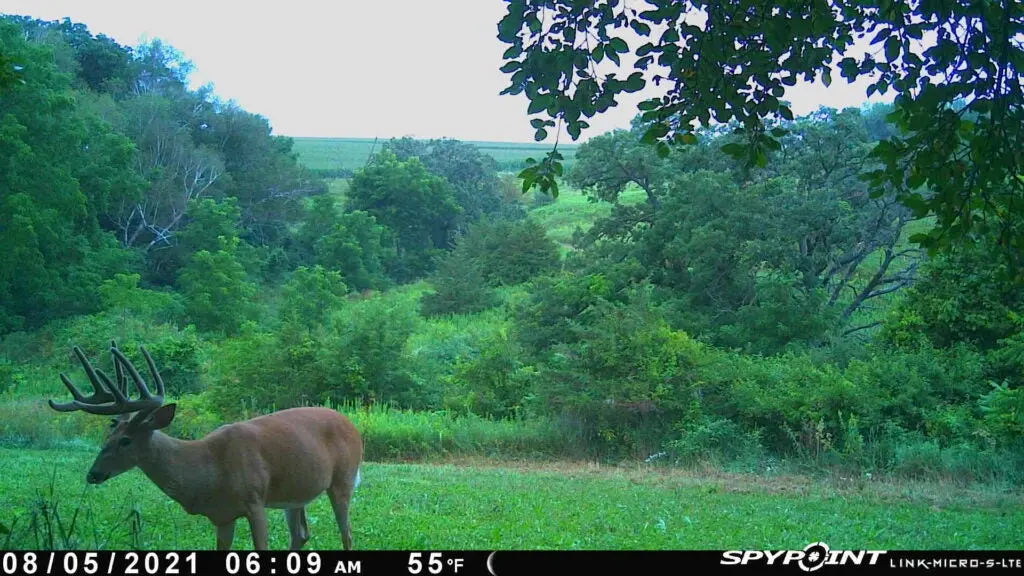
Trail cameras set on top food sources are a great way to pattern late-summer bucks. But you can do it with binoculars too. Scott Bestul
Success at the very beginning of the whitetail bow season is all about patterning whitetails in late summer on food sources and moving in on the opener if conditions are right. You can pattern these bucks with trail-cameras, as many do, but the absolute best way to pinpoint a buck now is through personal observation. Minnesota expert Bob Borowiak has tagged 30-some Pope and Young bucks, many on the very first day of the season. Here is his blueprint for taking a quick buck.
Stake Them Out
Many of the fields Borowiak hunts are easily visible from the road, so he starts by glassing from the cab of his truck. “Late-summer bucks are relaxed and coming out long before dark to feed,” he says. “I’m looking for any good bucks that show a consistent pattern.”
Get a Closer Look
In the wooded terrain Borowiak hunts, it’s often impossible to see the exact route a buck takes to a feeding area. So he moves closer. “I look for a tree where I can hang an observation stand that lets me view the action a little better,” he says. “But you need to be able to sneak in and out without the buck, or other deer, seeing or smelling you.”
Set the Trap
Within a week before the opener, Borowiak hangs a hunting stand. “I’ve usually picked the tree during one of my glassing sessions,” he says. “Many of my spots have a brushy hillside or an old apple orchard where the bucks stage before hitting the feed field. The best ambush is apt to be there, rather than right on the field edge.”
He hangs his stand at midday and returns as soon as the season is open and the wind is right. “Early-season bucks may not hit the field night after night like they did in summer. So don’t panic if he doesn’t show on the first hunt.” If you stick with it, you’ll almost always get your chance.
Early Season: Crash a Bachelor Buck Party
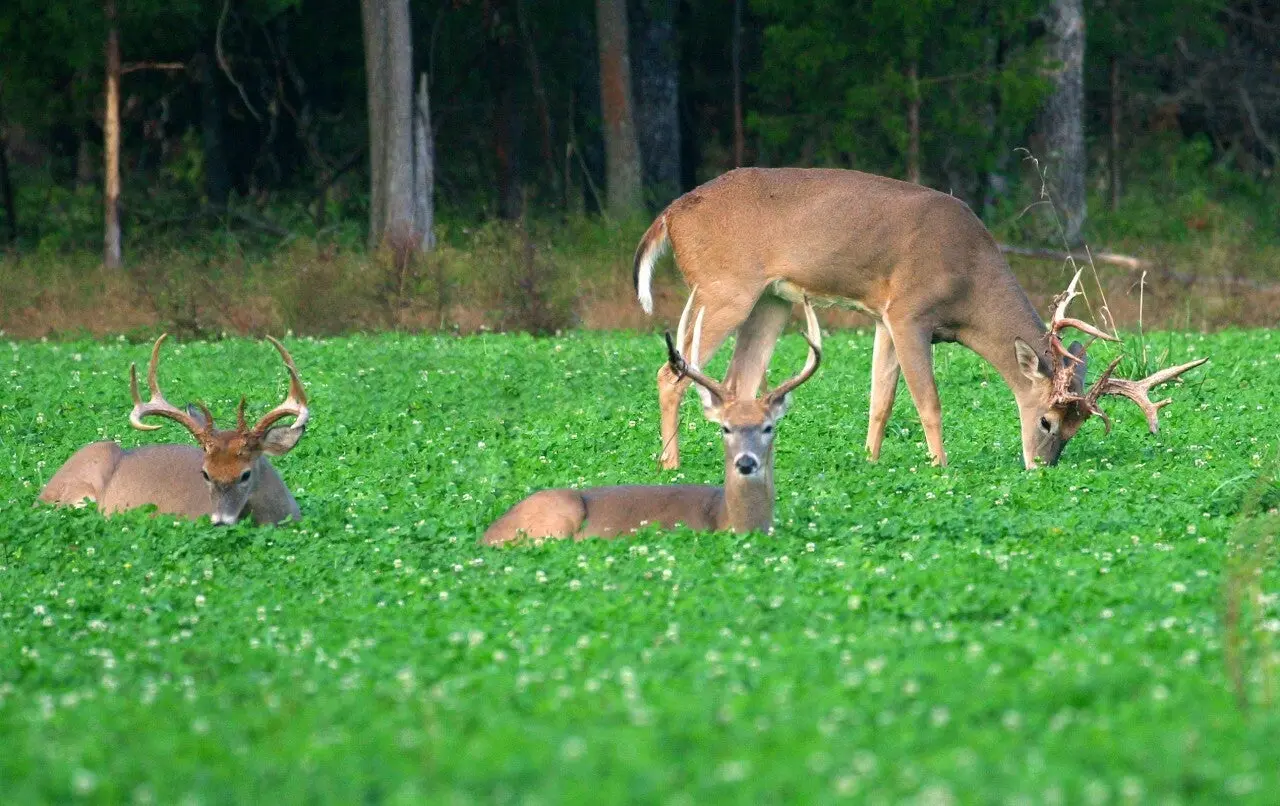
A bachelor group of bucks feeds and loafs in a food plot of Whitetail Institute’s Imperial Whitetail Clover. Whitetail Institute
What every early-season bowhunter hopes to find—and has a good chance of encountering before the end of September—is a bachelor group of bucks still on a predictable late-summer feeding pattern, in which they hit the same evening food source well before dark, day after day.
Tagging one of these boys can be a simple matter of long-distance patterning, stealthy stand hanging, and patience enough to wait for the right wind. Problem is, the biggest bachelor bucks have an annoying habit of entering feeding areas at oddball spots with fickle winds, an impossible approach, or lousy stand sites. Some guys will risk it anyway. They’ll move in and toss a Hail Mary. But most of them fail.
So what do you do?
Forget playing by the bucks’ rules and instead lure them to a spot where you’ve got the edge. While you’re at it, why not go for the biggest buck in the pack, too? Here’s how:
Step 1: Spy on Them
Glass the field from a distance for at least a couple of days, looking to nail down the bucks’ general direction of travel after they enter the field and as they feed. Note when they reach specific landmarks, like a tree, field corner, rock, or knoll.
Step 2: Stand Aside
Pick an alternate stand site in a mature tree upwind of their normal line of travel and within sight of a landmark that they reach before dark. It must allow for a covert entry and exit.
Step 3: Bluff Big
Put out a buck decoy that will test the ego of the bachelor group’s alpha male. If you’re after a really big buck, you might need to use a larger dominant-buck decoy. Position the fake within 15 yards of your stand, facing the animals’ normal entry. The real boss will interpret the stare of an unknown “rival” as an aggressive posture and trot over to adjust his attitude.
Step 4: Mouth Off
If shooting light is running out or the biggest bachelor isn’t spotting your deke, call to him with a grunt, light rattling, or a snort-wheeze. Once it’s clear he hears you, grab your bow fast. He’s apt to charge in the second his back hairs bristle. Even if it doesn’t happen, there’s a consolation: You’ve set up far enough off the action that you can come back and try again whenever the wind is right.
October Lull: Go Nuts on a Buck
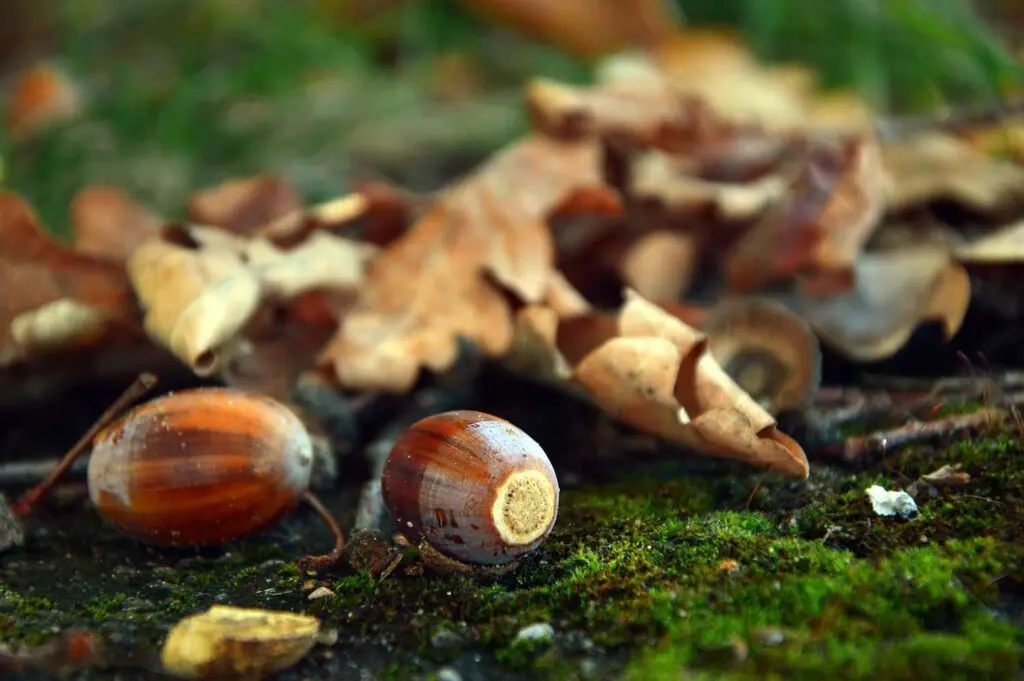
Look for acorns that fall without their caps. Peggy Choucair from Pixabay
One common cause of the so-called October lull is an abundant acorn drop. Whitetails simply don’t have to move far to find food, and hunters struggle to stay on the most active deer. Scouting for the “ice-cream tree”—that one oak or group of oaks with the best-tasting acorns—is a key to beating the lull.
Acorns without caps are an obvious sign of a sweet oak. Though they look perfectly healthy, capped acorns are invariably rotten or wormy inside, and whitetails avoid them.
Sometimes the hottest oaks have no acorns at all beneath them because the deer eat them as fast as they hit the ground. In that case, read between the lines and look for other evidence: churned-up leaves and droppings that indicate feeding activity, or other buck sign. Often the best oaks will be ringed by hastily made rubs.
My bowhunting buddy Tom VanDoorn used this trick a couple years back as we hunted northern Wisconsin’s big woods. Though we found multiple oaks dropping acorns, VanDoorn set up near a tree almost absent of nuts, but with gobs of buck sign. He shot a 150-class 12-point that night, one of four bucks that came in, waiting for the next acorn to fall.
**Related: 10 Ways to Beat the October Lull
**
Scrape Week: Find Big-Buck Paydirt
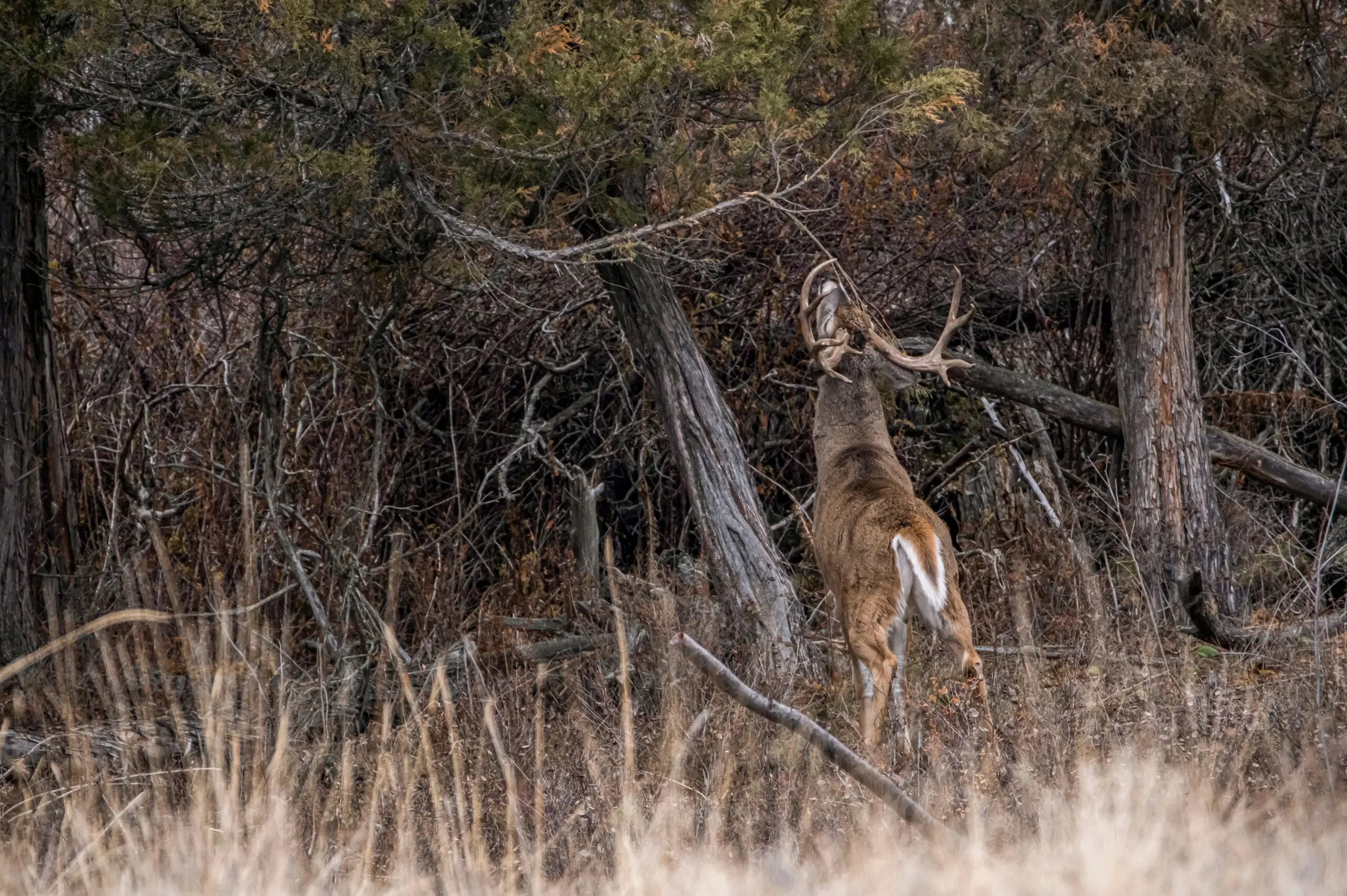
A nice whitetail buck works a scrape on the edge of a secluded swamp. John Hafner Photography
Scrapes can be the most maddening whitetail sign out there. While scrapes are obviously hugely important to bucks, you don’t have to run trail cameras or sit in a stand over one very long to realize that the vast majority of buck visits to active scrapes occur at night. In fact, those nocturnal fly-bys have caused some hunters I know almost ignore scrapes as hunting locations.
But that’s a big mistake, I’m convinced. Especially during a narrow window of the fall some experts I know describe as “scrape week.” If this were a specific 7-day period that could be counted on every year, hunting scrape week would be a slam-dunk. But like everything else in whitetail hunting, figuring it out can take some work.
Basically, I define scrape week as a five- to 10-day window when bucks are feeling the testosterone dump associated with the rut and increasing their activity but are still staying within their home ranges. In my area of the Midwest, scrape week usually kicks off during the last week of October.
It varies from year to year, but there is a surefire way to know it’s happening. Just keep a close eye on the trail cameras you have pointed at scrapes. When bucks start hitting them in daylight, you should jump into action. Sit a scrape—especially one close to a buck’s bedding area—during this time frame, and that once-frustrating buck sign can suddenly become your favorite.
Seeking Phase: Rattle In a Running Buck
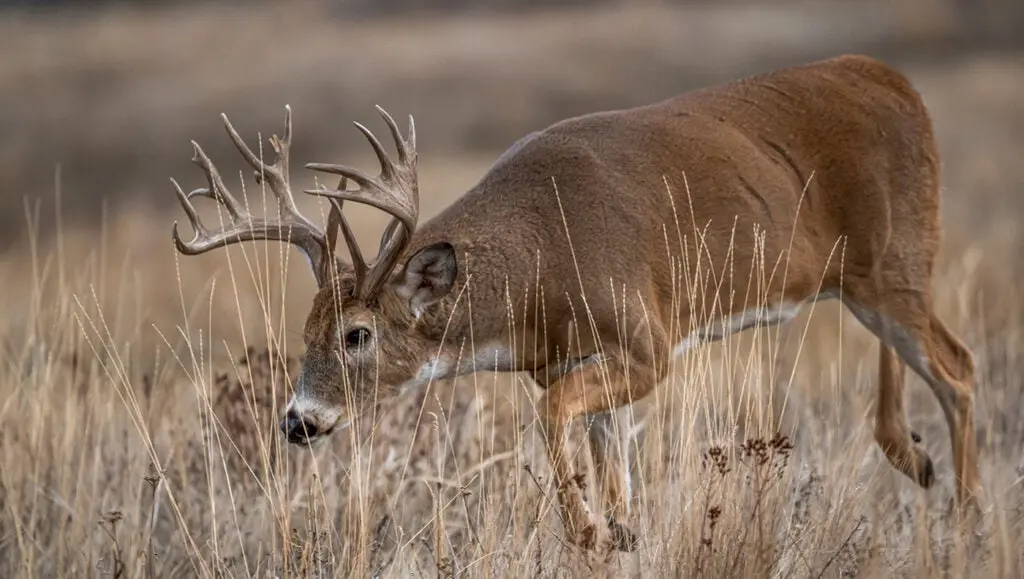
A buck that’s covering ground to find does can be pulled into bow range with rattling antlers. John Hafner Photography
The seeking phase of the rut usually kicks off around the first of November, give or take. For bucks, it’s the period when they really start covering ground to look for does in earnest. For me, it marks the time when I’ll switch things up and lean much more heavily on two things: morning hunts and rattling.
All that searching for does keeps bucks on their feet, and therefore in play, much later into the morning, and the sound of bucks fighting suggests there is a doe around that’s worth fighting over. So my favorite tactic now is to rattle loudly from a good morning stand.
It’s critical that you set up right for it, however, and that means hunting from a no-bust stand where, no matter how a deer approaches your setup, including from downwind, he’s not going to wind you. My favorite spots are areas where bucks will be back to their own bedding areas or checking out doe bedding area—including ridge ends, the top of a wash (or gully), and a hogsback on a ridge where several trails intersect.
In these high spots, all you need is a wind that blows your scent out over the valley, and even if a buck approaches from downwind or circles downwind of your rattling (as they tend to do), the elevation change will keep your scent well above him.
At first light, just grunt and tickle the horns, in case a buck is close. But then go ahead and rattle and rattle often. If you’re in a good spot, you can pull in multiple bucks over the course of the morning, so stay in the saddle until the action dies—or the buck you’re after does.
Chasing Phase: Get In On the Action
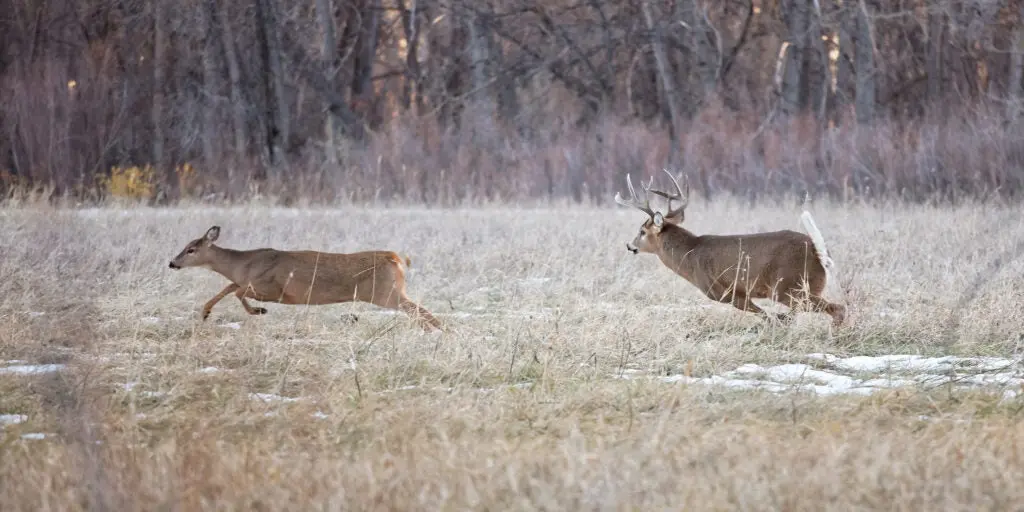
When bucks are chasing does, get close to the action and call aggressively. David C Stephens / Getty
The chasing phase is the most exciting stage of the rut and a time when bucks are highly vulnerable. But it’s all too brief and will be over before you know it if you don’t pay strict attention and be ready to react.
Ideally, you’ll see bucks dogging does. But finding kicked-up leaves or pine duff that reveals multiple sets of running tracks as another reliable indicator. You may also hear chasing: hooves scampering over dry leaves, sticks breaking, a buck grunting, even does snorting or bawling. In short, it sounds like a deer stampede.
You can expect the area where you’ve identified chasing activity to stay hot for several days. So go back there with a climber or featherweight hang-on stand and set up for an ambush. Where exactly should you sit? Favor thick doe betting cover, any natural travel lanes, or pinch points within the general area.
If you see or hear a chase happening nearby, and it doesn’t seem like the deer will come your way, call aggressively. Grunt, snort-wheeze, rattle. Remember, you need to make a lot of noise for running deer to hear you, and while it may seem unlikely that a buck with break away from a real doe to investigate your calling, the truth is that real does often shake their pursuers, and real bucks often lose track of the does they are chasing. When that happens, those bucks are very likely to come over for a look, so keep at it.
Peak Rut: Stake Out a Doe Bedroom
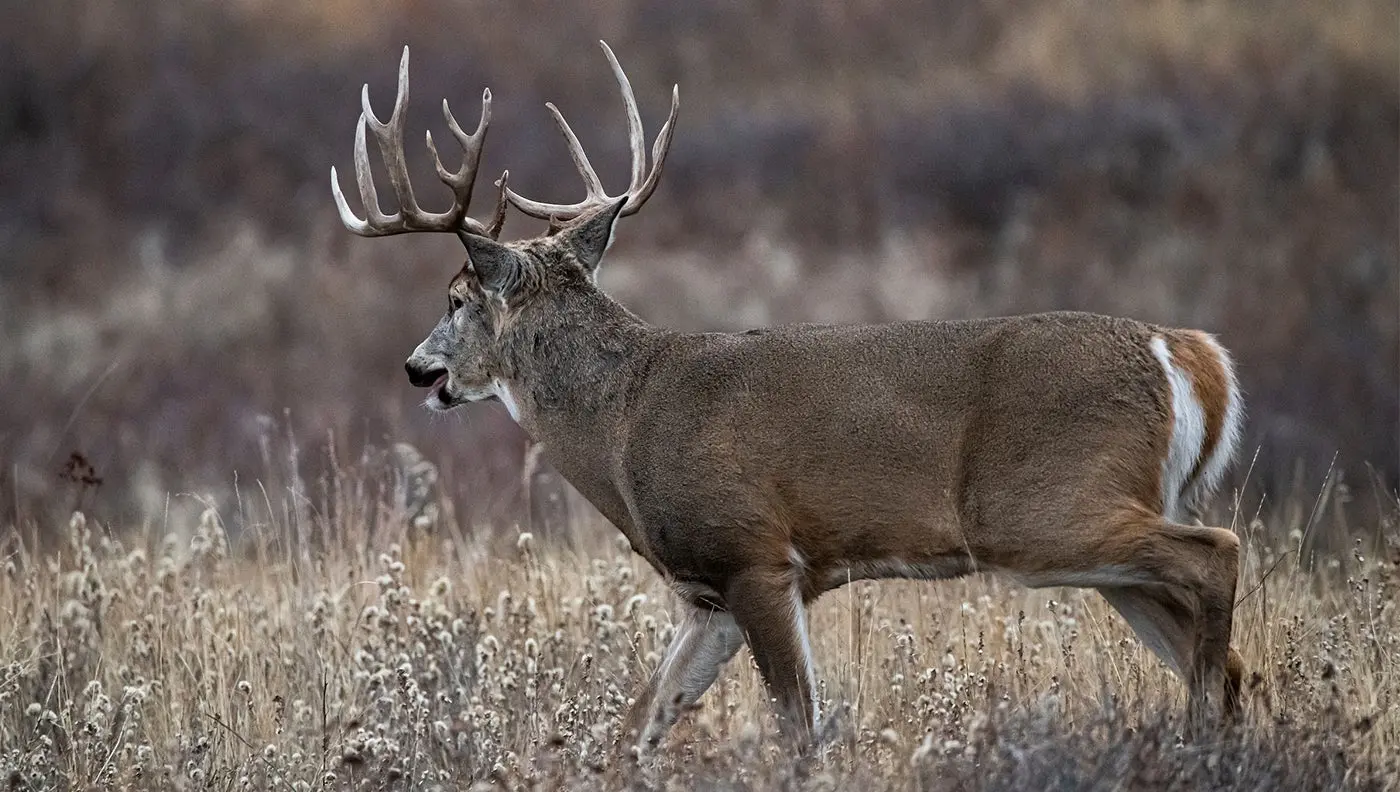
Count on big whitetails to be checking for bedded does now in brushy/grassy cover and thick woodlots. John Hafner Photography
With rutting bucks frantically searching for females, it makes perfect sense to camp out in prime doe feeding and bedding areas now. And with does spending most shooting hours on their bellies, it makes sense to start in their bedroom. Here is your three-step peak-rut bowhunting plan.
Step 1: Find the Beds
Start at prime doe feeding areas and walk into the woods, looking for gentle brushy knolls or benches, overgrown pastures, low pines, or tall grassy cover. Look for doe beds—groups of oval depressions of different sizes. Mark as many such bedding areas as possible on a topo map or scouting app. Then study your map for travel corridors that connects these places, such as creek beds, gullies, or thick cover.
Step 2: Set Up
Mature bucks will scent-check a group of does from the downwind edge of the bedding area, making this a prime spot to hang a stand. As the rut progresses, bucks will constantly move from one doe bedding area to the next along connecting travel routes, so hang stands there, too.
Step 3: Rotate
Does come into estrus at slightly different time periods. If the does is in a group seem nonchalant and mostly interested in eating, find a more active group. If you spot a large doe that’s particularly active, pacing around and glancing over her shoulder that deer is ready for a mate, and you should focus on her group. Check the first group again in a few days, unless you’ve are already got your buck.
Post Rut: Wait Out a Mega Buck
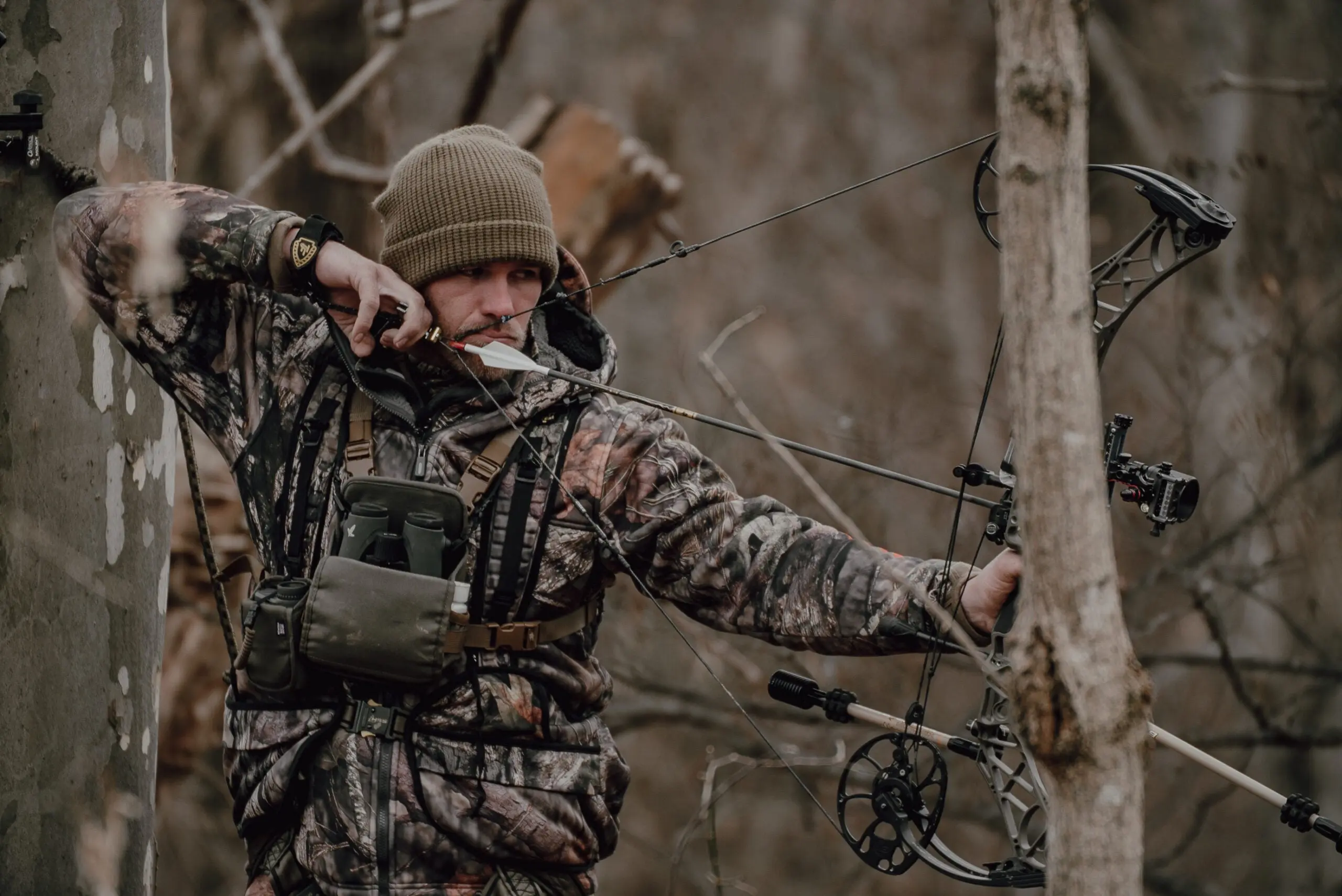
You won’t see many bucks during the post-rut, but the one you do see will probably be worth the wait. Levi Morgan
When the peak of whitetail rut is over, the couch begins to look more inviting than any tree stand to many hunters. That’s understandable. But if you’re serious about shooting the biggest buck of your life, you need to keep at it. Mature bucks are the only ones with the stamina to keep searching for the last estrous does. You won’t see near the number of bucks you do during the heart of the rut, but you could see the sort of buck that gives you no choice but to rack up a taxidermy bill. Here are two great places to sit.
Hunt a Macro Funnel
You want to focus on waylaying a big-running bruiser, so break out your online mapping app, your topo map, your aerial photo, and take a bird’s-eye look at the funnels connecting major food sources and bedding areas, even those located outside your hunting area. Think waterways, wooded creek or river bottoms, and ridge systems. These macro funnels are going to be the travel routes used by big bucks seeking far and wide for does. Hang a stand or set a blind in one of these (within your hunting area) and settle in for a long wait. If that book or game on your phone keeps you out there, by all means, use it. Your mission is to stay in the saddle long enough for a giant to show up.
Try Hidden Foods
Some bucks, including some really big boys, will take a short break from rutting to fill their growling bellies during this phase, but with gun seasons open across much of whitetail range now, and deer still a bit freaked out from the influx of pressure, you’ll want to find a secluded food source if you hope to see deer during daylight hours. Another good reason to set up on hidden food now is because even those big-cruising bucks know that does are never far from the grub as winter approaches. They will surely swing by hidey-hole food plots, oak ridges (especially ones that serve as funnels to other oak stands), or remote clearcuts now.
Late Season: Hunt the Hot Food
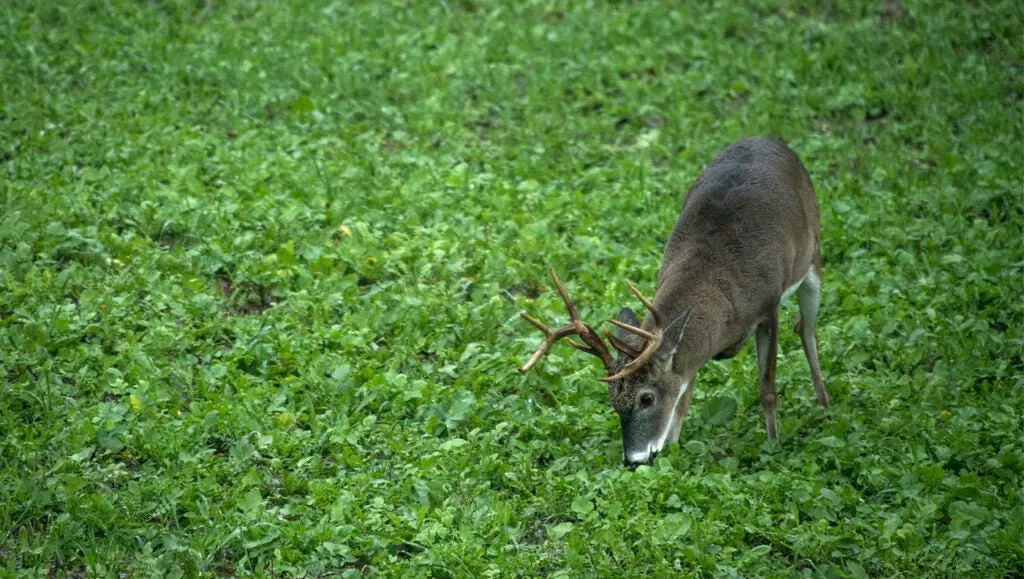
A late-season buck chows down in a plot of Biologic Final Forage. Biologic / Mossy Oak
For bowhunters, the late season is all about afternoon hunts on the hottest food sources you can find. Nobody knows that better than Mark Drury of Drury Outdoors. “When whitetails are focused solely on food, and you have found or planted what they want to eat, there’s no better time or place to kill a truly huge whitetail.”
Putting your tag on one is far from easy, though. You need loads of patience. You have to be willing to suffer bitter-cold conditions. And you’d better bring you’re A-game. “The smallest mistake will clear a field of feeding deer, and your hunt is over,” Drury says. But after decades of chasing these winter giants—and tagging more than 20 with an average score of 160 inches—he’s got it down to a system. Here it is, in his own words.
· Success in the winter starts in the summer, because it’s your off-season work that makes it all happen. The first key is to identify the best winter bedding areas, which around here means brushy south-facing slopes. Then you plant your food plots as close to those bedding slopes as possible, knowing that you’ll need good access to and from your hunting spots.
· Planting your own food helps, a lot, but it’s not a must for success now. There are plenty of ag fields pulling bucks off south-facing slopes across the country. Sacrifice a little hunting time and glass at prime time to find out where the deer are feeding.
· I move all my trail cams to food sources now to learn which are the hottest. The key is to switch them to time-lapse mode to get a field-wide view. Set them to capture the last few hours of shooting light.
· You can kill deer from a tree stand now, but a blind makes it easier. It gets you out of the wind and helps hide your fidgeting. We put ours 6 to 8 feet up on wooden platforms, above a deer’s line of sight. But you still have to be very careful about movement inside the blind.
· Sunny days with high pressure are hands-down the best now.
· Most hunters know that a bitter-cold day, especially the first couple of the season, can really get deer on their feet and feeding. But my journals have proven to me that the first warm day or two after a big cold front is just as good. Not only will deer feed, but they’ll also be out early. And this goes for even the biggest deer, so you want to be sure to be in your blind then.
· The hardest part is leaving your blind without spooking a field full of deer. The best solution is to have someone drive into the field and right to your hide with a truck or tractor. That doesn’t bother farmland deer. Lacking that, I’ll just wait until full dark and walk out if it’s windy. On calmer nights, I’ll owl-hoot or coyote-howl, which almost always clears the field and allows me to slip out of there.
· Hunting now requires a short memory. It’s so cold, stuff doesn’t work like it should, and the deer are psychotic. Everything is a struggle, and it’s easy to fail night after night. But you have to keep your head in the game because eventually, maybe in the next few minutes, you’ll get your chance to kill an absolute giant.
**Related: How to Create the Perfect Late-Season Deer Stand
**



